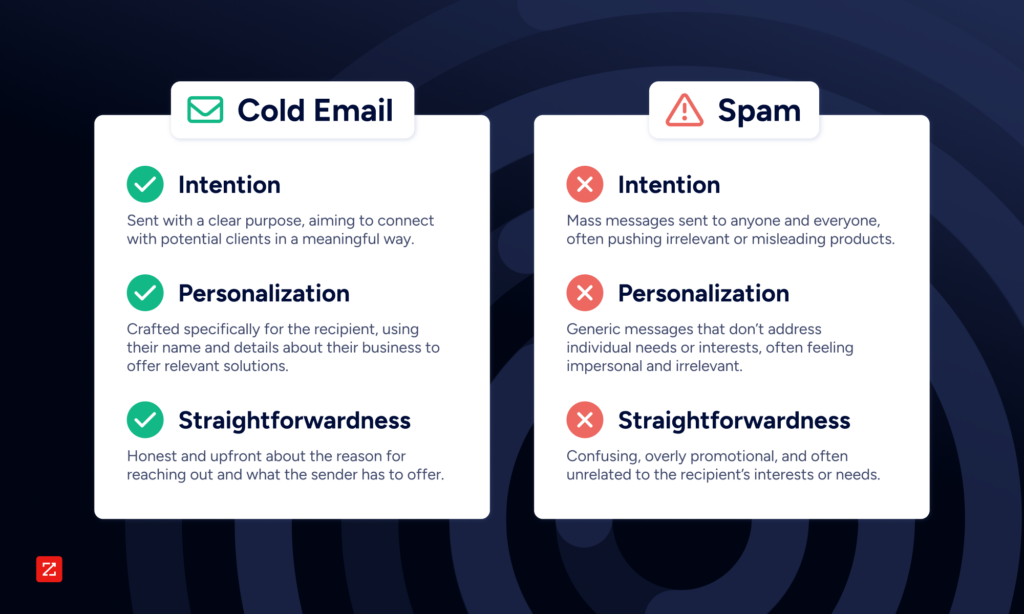In a world obsessed with the shiny and new, the 50-year-old technology of email remains a cornerstone of lead generation and marketing strategies.
However, there’s a clear line between a compelling cold outreach email that opens doors to new opportunities and spam that will tarnish a brand’s reputation. Understanding the distinctions between the two is crucial for anyone looking to effectively communicate with potential customers.
Here are three key differences between lead generation emails and spam, and eight best practices to improve cold email performance — and avoid spam— that every go-to-market professional should know.
First thing: Compliance
Identifying and improving your email practices starts with understanding the legal landscape. Each country has its own law governing the sending of cold emails.
Here’s a simplified overview of each:
CAN-SPAM: Does not require consent for cold-emailing.
PECR: Does not require consent for cold-emailing in a B2B context.
UWG: Requires consent in all cases.
It’s important to understand these baseline differences and to consult your legal counsel for any outstanding questions. For the purposes of this article, we will be focusing on situations where cold-emailing is acceptable under the law.
Is Cold Email Legal?
This will depend upon the country the recipient lives in. Where consent is not required, cold emailing is legal, but it must conform to applicable regulations to avoid crossing the line into spam territory. Again, it’s why seeking legal counsel is important.
Three Key Differences Between Cold Emails and Spam
Key differences between cold emails and spam

Kevin Hopkinson, who manages marketing operations at ZoomInfo, outlines the three elements that differentiate cold emails from spam.
1. Intention
A key difference between cold emails and spam is the intent of the message.
“Targeted cold email lists involve a personalized message sent to potential clients or contacts with legitimate business intent,” Hopkinson says. “Spam, on the other hand, is unsolicited bulk messaging sent indiscriminately, such as promoting irrelevant or misleading products to random unqualified contacts.”
2. Personalization
Effective cold emails are personalized. They address the recipient by name, reference specific details about their business or role, and offer solutions tailored to their needs. Spam emails lack this personalization, appearing generic and often irrelevant to the recipient.
“Tailoring content to the recipient’s preferences, behaviors, and past interactions enhances customer experience, fosters brand loyalty, and allows conversations to quickly improve into conversions with relevance and value,” Hopkinson says.
3. Straightforwardness
Well-crafted cold emails are transparent about their purpose. They clearly state why the sender is reaching out and what they are offering. “Spam is vague, overly promotional, and irrelevant in every way to the audience receiving it,” Hopkinson says.
Eight Ways to Improve Cold Emails and Avoid the Spam Folder
1. Personal vs. Generic Messaging
Cold Outreach: Tailored to the recipient, cold outreach emails typically start with personalized greetings and mention details specific to the individual or their company. This approach shows that you have done your research and presents a genuine potential for a mutually beneficial relationship.
Spam: A spam message is the polar opposite, with generic greetings like “Dear Sir/Madam,” or no personalization at all. These emails are sent in bulk and lack any specific details relevant to the audience and the business they’re targeting.
2. Relevance vs. Randomness
Cold Outreach: Even though your message might be considered “cold” because you’re making the first move, an effective outreach email is highly targeted and sent to individuals or businesses that you specifically identified as potentially benefiting from your products or services. The content is crafted to address the recipient’s possible current needs, problems, or situation, making it relevant and timely.
Spam: These messages are sent out to a wide, indiscriminate audience without any consideration for the recipient’s interests, needs, or even industry. The lack of relevance — with no targeting, customization, or forethought — is a hallmark of spam emails.
3. Unsubscribing: Respectful Compliance vs. Deliberate Evasion
Cold Outreach: Demonstrate respect for the recipient’s autonomy by providing a clear, straightforward method for unsubscribing from future communications. This is not only a legal requirement under laws like CAN-SPAM, but also a sign of your commitment to maintaining a respectful relationship with your customers. By making the unsubscribe process simple — and honoring it promptly — you’re communicating that you value the recipient’s preferences and consent.
Spam: Actual spam will make it difficult, if not impossible, for recipients to opt out of future messages. They may hide the unsubscribe link, make the process convoluted, or ignore unsubscribe requests altogether. This frustrates recipients and violates email marketing regulations, clearly demonstrating a disregard for recipient preferences.
4. Value Proposition vs. Empty Promises
Cold Outreach: Provides clear value to the recipient, whether it’s through informative content, an offer, or an invitation to discuss potential solutions to their problems. The intention is to start a conversation based on the recipient’s needs and interests. Any offer should have tangible value.
Spam: Offers little more than empty calories, packed with exaggerated claims and deals that are too good to be true. These emails are typically self-serving, offer little value, and aren’t beneficial or relevant to the recipient.
5. Frequency and Timing vs. Bombardment
Cold Outreach: Emails are sent at a frequency that respects the recipient’s time. Follow-up emails are spaced out to give them time to consider your offer without feeling pressured. Non-engagement over time should lead to a sunsetting policy where the recipient is automatically removed from your list.
Spam: Sent repeatedly and at random, flooding the recipient’s inbox, and often prompting them to mark the email as spam. Regardless of engagement, emails will continue to be delivered as long as the email does not bounce.
6. Professional Branding vs. Suspicious Elements
Cold Outreach: Reflects professionalism and includes proper branding elements that reassure the recipient of the email’s legitimacy. These emails are well-written, free of errors, sent using a brand-specific domain, and aim to build trust and credibility.
Spam: May contain suspicious elements, such as misleading cold email subject lines, poor spelling and grammar, or a lack of professional branding.
7. Building Relationships vs. Immediate Conversions
Cold Outreach: Seeks to lay the foundation for a beneficial relationship. These emails prioritize engagement and dialogue over immediate sales, recognizing that trust and rapport are prerequisites to conversion.
Spam: Eyes the short-term prize, pushing for a quick conversion with little regard for the recipient’s readiness or interest.
8. Authentication: Trustworthiness vs. Anonymity
Cold Outreach: Will conform with traditional email authentication standards such as the Sender Policy Framework (SPF) and DomainKeys Identified Mail (DKIM) that points back to the sender’s email domain, and have a DMARC (Domain-based Message Authentication, Reporting, and Conformance) policy published to the sender’s domain. These technologies verify your identity, ensuring for the recipient that the email originated from your stated domain and wasn’t altered in transit.
When companies demonstrate their commitment to security and trustworthiness, recipients and email service providers can more easily verify the legitimacy of these emails, which helps build trust and improve deliverability rates.
Spam: Less likely to use authentication methods effectively — if at all. Spammers often attempt to disguise their identity or use compromised accounts and domains. A lack of proper authentication often indicates that email is illegitimate and undermines trust between the sender and the recipient.
Bonus: Four Tips to Avoid Being Marked as Spam
Here are four quick tips to ensure your cold emails are not classified as spam:
Avoid misleading subject lines: Be sure your subject lines are clear and accurately reflect the content of your email. Misleading subject lines containing spam trigger words can cause recipients to mark your email as spam.
Provide a clear unsubscribe option: Always include an easy-to-find and straightforward way for recipients to opt out of future emails. This not only complies with legal requirements, but also builds trust with your audience.
Use a recognizable sender name: Make sure your sender name is easily recognizable and consistent. Recipients are more likely to open emails from a familiar name. This consistency helps build trust.
Monitor your email engagement: Pay attention to how recipients interact with your emails. High bounce rates, low open rates, and high spam complaints harm your sender reputation, which harms the outcomes of your email campaigns. Regularly clean your email list to remove unengaged subscribers to improve deliverability.
Rethinking Cold Email Outreach
Remember, effective email marketing is not about the quantity of emails sent, but the quality, respect, and relevance of the communication to your target audience.
Before hitting send, make sure you’re working with data providers and email apps that emphasize strict adherence to industry and government privacy standards, significant investments in data hygiene and R&D, and high-quality, wide-ranging buying signals that help ensure your email outreach is targeted, relevant, and in compliance.
Happy emailing — for both sender and recipient.


